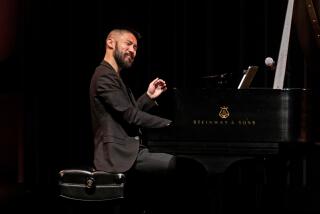MUSIC REVIEW : For ‘Last of Romantic’ Pianists the Interpretation Comes First
- Share via
LA JOLLA — When Vladimir Horowitz died in 1989, the New York music critics eagerly crowned Shura Cherkassky the last of the Romantic pianists. From Cherkassky’s playing in a solo recital Friday night at Sherwood Auditorium, it is clear that the 79-year-old Russian-born musician’s particular brand of Romanticism values self-willed interpretation above all. The pianist is king and the composer his servant.
This trait cannot simply be a factor of age. Neither Rudolf Firkusny nor Gyorgy Sandor, to cite two of Cherkassky’s contemporaries who are still performing, subjugate the composer to their individual personalities. In fact, Firkusny and Sandor represent a paradigm of balance between subjective conviction and objective illumination of the score.
But over his long career, Cherkassky has retained his own Romantic muse--a pictorial, highly evocative keyboard style--without acquiring a healthy respect for the stylistic individuality of the many composers he performs.
His program-opening Beethoven “Eroica” Variations and Fugue, Op. 35, sounded more like a Robert Schumann suite, a sequence of colorful vignettes, than the progressive variation of a single theme culminating in a fugue. And Cherkassky’s halting, disjunct interpretation of the fugue deconstructed every joist of its structural logic.
In Franz Liszt’s “Venezia e Napoli,” Cherkassky reveled in splashy display and brilliant figuration. The work’s episodic structure fit his approach like a glove. A wizard at creating a series of boldly profiled musical effects, Cherkassky was a colorist whose firm touch commanded deep, robust sonorities from the Steinway. His aggressive attack of the keys bordered on the heavy-handed, and the ear waited in vain for a warm, ingratiating sound from the piano. But in terms of dexterity and technical prowess, Liszt’s “Venezia e Napoli” proved that he had the goods.
What worked for Liszt’s musical postcards, however, completely undermined the Brahms Third Piano Sonata. Not only did Cherkassky fail to illuminate the sonata’s grand architectural design, but also his erratic tempos in the scherzo distorted the music quite shamelessly.
His Chopin G Minor Ballade proved the evening’s most conventional offering. But the first movement of Alexander Scriabin’s Fourth Sonata, Op. 30, lacked the graceful touch and mystical air that prevents Scriabin from sounding like second-rate Chopin. Cherkassky’s route of the sonata’s bravura finale brought down the ample Sherwood house.
More to Read
The biggest entertainment stories
Get our big stories about Hollywood, film, television, music, arts, culture and more right in your inbox as soon as they publish.
You may occasionally receive promotional content from the Los Angeles Times.










